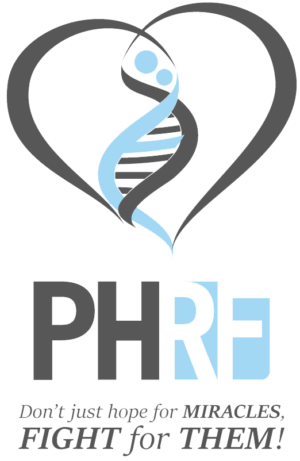Perhaps you’ve noticed your baby missing milestones?
The Pitt Hopkins Research Foundation is determined to help as many families as possible find the right diagnosis for their child, whether the diagnosis is Pitt Hopkins or not. To that end, we have two useful tools that might help:
First, we have partnered with Probably Genetic (probablygenetic.com) to help more families have access to FREE genetic testing. Fill out the symptom tracker below to see whether you might qualify.
Second, take a look at our diagnostic criteria below.
Diagnostic Criteria
Author: Raoul Hennekam MD PhD, Professor of Paediatrics and Translational Genetics, University of Amsterdam, The Netherlands, Summer 2010
Children and adults with Pitt-Hopkins show many resemblances. But next to this they also show many resemblances with their parents, including well recognizable family traits. All characteristics mentioned below can therefore change in their expression or their presence.
Characteristics in the Appearance
Individuals with Pitt-Hopkins have a small head circumference, and their forehead recedes somewhat when compared to the cheeks and jaw.
The nose: the base of the nose is broad, the tip of the nose full, and the alae of the nose often flare a bit;
The mouth: this is broad, with the sides of the upper lip running upwards, and the middle of the upper lip going down again; the lips look as if they are ready to kiss someone (in medical terms this is called cupid-shape); the lower lip is full;
The ears: the outer border of the ears (helices) are often thick and the ears themselves are prominent;
The tips of the fingers: these have often a characteristic shape, as they become towards the tip broader with convex nails. At the inside of the fingertips and also the tips of the toes one can see soft small hillocks (in medical terms these are called fetal pads).
Most children grow slowly and remain short compared to their parents, although this is usually not very marked.
Health Problems
The muscle tone is low (hypotonia). Because of this there are often feeding problems in the first years of life as the child is less able to suck well. The low muscle tone is also one of the causes of the slow motor development. Early stimulation with support by a paediatric physical therapist and speech therapist can be very useful.
In some of the children their way of walking is unusual. Both by the hypotonia and the incorrect coordination of the movements of arms and legs (ataxia) the child will learn to walk only at a later age and their gait looks stiff.
Children with Pitt-Hopkins can have periods of very unusual breathing patterns. Usually it manifests between their 5th and 10th year of age, but earlier or much later (sometimes only in early adulthood) has been observed as well. A typical pattern is a few minutes very fast breathing (hyperpnoea), followed by a period during which the child stops breathing completely (apnoea). This pattern can be present repeatedly, also within a short period of time. Both fast breathing or temporarily no breathing can occur separately as well. During sleep breathing is usually normal. During the fast breathing the child swallows a lot more air, which enters the belly and gut, and causes a distended belly. See MEDICAL ISSUES Page under ABOUT PITT HOPKINS for more information on apnea.
Many children have constipation. In a single child the cause for this was the presence of Hirschsprung disease (abnormal functioning of the nerves in the gut wall), but in most other children it remains uncertain why they have constipation.
A less frequent problem is epilepsy. It reacts well using the usual therapeutic regimes. The EEG in these children is abnormal. If a brain MRI is available one can often see underdevelopment of the corpus callosum (structure between the left and right side of the brain) and a convex nucleus caudatus.
Behavioral Characteristics
The behavior is busy and always moving. Many children are flapping their hands when they are excited. Their character is normally devoted, happy and cheerful. Some can have bouts of laughter without a clear reason for this. In this respect they can resemble Angelman syndrome in which children show a similar behavior.
Development
Children and adults with Pitt-Hopkins are developmentally delayed. The children slowly reach their motor milestones like rolling over, sitting and walking. Most children will not have any speech although some children can use some words and a few can speak reasonably well. For communication a training to use sign language and pictures is very important.

